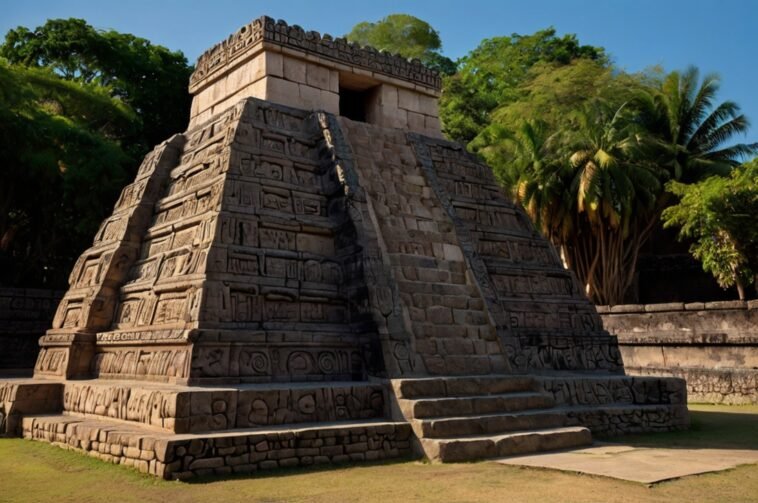
Mesoamerican religion and mythology are among the most fascinating in world history, shaped by the deep spiritual beliefs and intricate cosmology of cultures such as the Maya, Aztec, and Olmec.
From creation myths that explain the origins of the universe to complex deities representing various aspects of life, Mesoamerican societies wove their mythology into daily life, agriculture, warfare, and governance.
Today, we’ll explore some of the key aspects of Mesoamerican religion, including creation myths, major deities, rituals, and the legacy these beliefs have left behind.
Creation Myths and Cosmology
The question of how the world began is central to Mesoamerican mythology.
Several different myths explain the creation of the universe, humanity, and even time itself, with each culture offering its own version of events.
Popol Vuh (Maya)
The Popol Vuh is one of the most significant texts in Maya mythology, often likened to the “Maya Bible.”
Although it was written after the Spanish conquest, it draws heavily on ancient oral traditions.
This text recounts the creation of the world and describes how the gods made multiple attempts to create humans.
In a well-known story from the Popol Vuh, the gods first tried to create humans from mud, but these beings were weak and fell apart.
Then, they made humans from wood, but these wooden beings lacked souls and emotions, so they were destroyed.
Finally, after many failures, the gods succeeded in crafting humans from corn, which holds sacred significance in Maya society as a vital food source.
- Read also: The Mayan Pantheon: Exploring the Deities of an Ancient Civilization
- Read also: Markets of the Past: Detailed About Mesoamerican Trade Networks
Tezcatlipoca and Quetzalcoatl (Aztec)
creating the world through multiple cycles known as “Suns.”
According to Aztec cosmology, the universe has undergone five Suns, each representing a different age that ends in destruction, followed by renewal.
Tezcatlipoca, whose name means “Smoking Mirror,” and Quetzalcoatl, the “Feathered Serpent,” often battled each other, symbolizing the struggle between creation and destruction.
Their rivalry was central to the Aztec understanding of how the world operates, highlighting the importance of conflict and balance in the universe.
Other Creation Myths
While the myths of the Maya and Aztec civilizations are among the most documented, other Mesoamerican cultures, such as the Olmec and Zapotec, also had their own creation stories.
These myths often involved gods forming the world from primordial waters or mountains.
They emphasized the cyclical nature of time, where creation and destruction are ongoing processes.

Major Deities and Their Roles
Mesoamerican pantheons were full of gods and goddesses, each representing natural elements, human endeavors, and cosmic forces.
Quetzalcoatl (Aztec and Maya)
Quetzalcoatl is one of the most revered deities in both Aztec and Maya cultures.
Known as the “Feathered Serpent,” he represents wisdom, wind, learning, and fertility.
In Aztec mythology, Quetzalcoatl is credited with creating humanity by using his own blood to resurrect the bones of earlier creations.
He is also associated with introducing agriculture, particularly maize (corn), to humanity, underscoring his importance in both society and mythology.
Tezcatlipoca (Aztec)
Tezcatlipoca, often depicted with a black mirror that symbolizes his powers of divination, is the god of the night, destiny, and chaos.
He serves as a rival to Quetzalcoatl, and their conflicts were essential to Aztec creation myths.
Tezcatlipoca is a complex figure, representing war, sorcery, and kingship, illustrating that Mesoamerican deities could embody both positive and negative traits.
Huitzilopochtli (Aztec)
Huitzilopochtli is the Aztec god of the sun and war, particularly important to the Mexica people, who were the core tribe of the Aztec Empire.
His name translates to “Hummingbird of the South,” and he is believed to have guided the Aztecs to their capital, Tenochtitlan.
To maintain his power and ensure the sun’s movement across the sky, Huitzilopochtli demanded human sacrifices, reflecting the importance of rituals in Aztec society.
Other important deities
- Tlaloc (Aztec): The god of rain, storms, and fertility, essential for agriculture.
- Chac (Maya): The rain and agriculture god, vital for sustaining crops.
- Xipe Totec (Aztec): The god of agriculture, seasons, and renewal, linked to the cycle of life and death.

Rituals and Ceremonies
Religion in Mesoamerica wasn’t just about worship—it involved elaborate ceremonies that maintained the balance of the cosmos.
These rituals ranged from feasts and prayers to more extreme practices like human sacrifice.
Human sacrifice
Human sacrifice played a central role in many Mesoamerican religions, especially in the Aztec tradition.
The Aztecs believed that the gods needed nourishment in the form of human blood to sustain life and keep the universe in balance.
Sacrificial ceremonies were often dedicated to deities like Huitzilopochtli, the god of the sun and war, or Tlaloc, the god of rain. Prisoners of war were frequently used as sacrifices, and these events were both religious and political in nature.
While it’s difficult to know the exact number of sacrifices, some historians estimate that thousands of people were sacrificed each year during the height of the Aztec Empire.
However, the actual figures are still debated.
Other rituals
In addition to human sacrifice, Mesoamerican cultures practiced bloodletting, a ritual in which people would cut themselves to offer their own blood to the gods.
This was seen as a deeply personal form of devotion. Other common rituals included offering food, incense, and handmade items to the gods.
Music, dancing, and elaborate ceremonies were also part of honoring the deities, creating a vibrant and spiritual atmosphere.
Calendars and timekeeping
Mesoamerican cultures were highly advanced in their understanding of time and developed complex calendars to guide their religious and agricultural activities.
The Maya used the Tzolk’in calendar and the Aztecs used the Tonalpohualli, both of which were 260-day sacred calendars.
These calendars were essential for planning religious ceremonies, determining the timing of important agricultural events, and even guiding decisions in warfare.

Mesoamerican Beliefs and Philosophy
Mesoamerican religion wasn’t just about rituals and deities—it also involved deep philosophical ideas about existence, duality, and the nature of life and death.
Dualism
The concept of duality was at the heart of Mesoamerican philosophy. Many of their gods embodied opposing yet complementary forces.
For instance, deities like Quetzalcoatl and Tezcatlipoca represented creation and destruction, light and darkness, or life and death.
These opposing forces were seen as necessary for balance in the universe. In this worldview, life couldn’t exist without death, and creation needed destruction to occur.
The afterlife
In Mesoamerican beliefs, the afterlife was not one simple idea—it was a complex journey with different paths depending on how a person died.
For the Aztecs, the way someone left this world determined where their soul would go.
Warriors who died in battle and women who passed during childbirth were believed to join the sun god in a glorious afterlife.
Others might have to travel through Mictlan, the underworld, a long and challenging journey filled with obstacles before they could finally rest.
The sacred and the profane
Mesoamericans made a clear distinction between the sacred and the profane (ordinary).
Sacred things were connected to the gods, the cosmos, and the rituals that kept the universe in harmony, while profane things were tied to the everyday aspects of life.
Certain places, objects, and times were considered sacred, such as temples, special ceremonial items, and specific days on their calendars.
This separation between the sacred and the everyday was crucial for how their societies were organized, giving purpose and meaning to their rituals and their lives.

The Legacy of Mesoamerican Religion and Mythology
The religious beliefs and myths of Mesoamerica didn’t vanish when the Spanish arrived.
Instead, many elements of these ancient traditions survived, blending with Christianity to create unique spiritual practices that are still alive in parts of Mexico and Central America today.
Cultural impact
One of the most visible legacies of Mesoamerican religion is the celebration of Día de los Muertos (Day of the Dead).
This vibrant festival, which honors deceased loved ones, has deep roots in ancient Mesoamerican beliefs about death and the afterlife.
It reflects the idea that death is not the end but a transition to another realm.
Even centuries after the Spanish conquest, traditions like these continue to show the lasting influence of Mesoamerican religions, highlighting how ancient ideas can evolve and remain relevant in modern cultures.
- Read also: Deciphering the Glyphs: The Mesoamerican Writing Systems
- Read also: The Mesopotamian Pantheon: A Journey into Ancient Deities
Final Thoughts
Mesoamerican religion and mythology offer a complex, yet captivating, glimpse into the spiritual world of ancient civilizations.
From their rich pantheon of gods to their dramatic rituals, these cultures viewed the world as a deeply interconnected place where humans, nature, and the divine were in constant dialogue.
Understanding these beliefs not only helps us appreciate the rich history of Mesoamerica but also highlights how ancient civilizations shaped their worlds through faith and storytelling.



